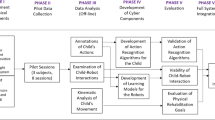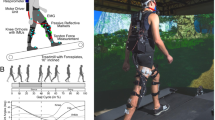Abstract
Self-generated mobility via locomotion is a key for the cognitive, social and motor development of young infants. For certain children with special needs, self-generated mobility is only attained via assistive technology such as a power wheelchair. Up until recently, infants under 24 months of age were not considered candidates for training in power mobility. Recent work in our labs and others suggest that younger infants can utilize their reaching and grasping ability to learn power mobility. This interdisciplinary study combines our previous work in motor development and learning in infants with special needs, and the application of robot technology for rehabilitation to determine whether young infants without structured training, would drive a mobile robot, and if so, to determine how their driving would change over multiple sessions. The two infants that were seen for the most sessions were the focus of this pilot study. Both infants increased their total session time, percentage of session time spent driving, and total path length. These results suggest that, without training, young infants will independently move themselves using a mobile robot. These results provide the foundation for training studies to advance the self-generated mobility in young infants with special needs. Our future studies will explore the multiple training and technology combinations to reduce the barriers to exploration via self-generated mobility, and advance the general development of infants with special needs.
Similar content being viewed by others
References
Anderson DI (2000) Can prelocomotor infants learn to control a powered mobility device? Paper presented at the International Society for the study of behavioral development Biennial conference, Beijing, China, July
Anderson DI, Campos JJ (2000) The ontogeny of postural responsiveness to peripheral optic flow: experimental manipulation of a developmental process. Paper presented at the Fifth Biennial motor control and human skill research workshop. Gold Coast, Australia, Januaray
Anderson DI, Campos JJ, Barbu-Roth MA, Uchiyama I (1999) Motor behavior and psychological function. Paper presented at the North American Society for the psychology of sport and physical activity. Clearwater Beach, FL, June
Anderson DI, Campos JJ, Anderson DE, Thomas TD, Witherington DC, Uchiyama I and Barbu-Roth MA (2001). The flip side of perception–action coupling: locomotor experience and ontogeny of visual-postural coupling. Human Movem Sci 20: 461–487
Bensen JB and Uzgiris IC (1985). Effect of self-initiated locomotion on infant search activity. Develop Psychol 21: 923–931
Bhat A and Galloway JC (2006). Toy-oriented changes during early arm movements: hand kinematics. Infant Behav Develop 29: 358–372
Bhat A, Galloway JC (2008) Toy-oriented changes during early arm movements III: Constraints on Joint Kinematics. Infant Behav Develop (in press)
Bhat A, Heathcock J and Galloway JC (2005). Toy-oriented changes in hand and joint kinematics during early infancy: a cross-sectional study. Infant Behav Develop 28: 445–465
Bhat A, Lee HM and Galloway JC (2007). Toy-oriented changes during early arm movements II: Joint kinematics. Infant Behavior and Development 30: 307–324
Butler GA (1986). Effects of powered mobility on self-initiated behaviors of very young children with locomotor disability. Develop Med Child Neurol 28: 325–332
Butler GA, Okamoto, McKay TM (1984) Motorized wheelchair driving by disabled children. Archi Phys Med Rehabili 65:95–97
Campos JJ, Anderson DI, Barbu-Roth MA, Hubbard WM, Hertenstein MJ and Witherington D (2000). Travel broadens the mind. Infancy 1: 149–219
Corbetta D and Bojczyk KE (2002). Infants return to two-handed reaching when they are learning to walk. J Motor Behav 34(1): 83–95
Corbetta D, Thelen E and Johnson K (2001). Motor constraints on the development of perception–action matching in infant reaching. Infant Behav Development 23: 351–374
Diedrich FJ, Highlands T, Spahr K, Thelen E and Smith LB (2001). The role of target distinctiveness in infant perseverative reaching errors. J Exp Child Psychol 78: 263–290
Dugan LM, Campbell PH and Wilcox MJ (2006). Making decisions about assistive technology with infants and toddlers. Top Early Child Spec Educat 26: 25–32
Eppler MA (1995). Development of manipulatory skills and the deployment of attention. Infant Behav Develop 18: 391–405
Fogel A, Dedo JY and McEwen I (1992). Effect of postural position and reaching on gaze during mother infant face-to-face interaction. Infant Behav Develop 15(2): 231–244
Fogel A, Messsinger DS, Yale ME, Disckson KL and Hsu H (1999). Posture and gaze in early mother-infant communication: Synchronization of developmental trajectories. Develop Sci 2(3): 325–332
Galloway JC and Thelen E (2003). Feet first: Object exploration in human infants. Infant Behav Develop 27(1): 107–112
Goldfield E (1990). Transition from rocking to crawling: postural constraints on infant movement. Develop Psychol 25(6): 913–919
Hao Y and Agrawal SK (2005). Formation planning and control of UGVs with trailers. Autonom Robots 19(3): 257–270
Hao Y and Agrawal SK (2005). Planning and control of UGV formations in a dynamic environment: a practical framework with experiments. Robot Autonom Syst 51: 101–110
Hays RM (1987) Childhood motor impairments: clinical overview and scope of the problem. In: Jaffe KM (eds) Childhood powered mobility: developmental, technical, and clinical perspectives. Proceedings of the RESNA first northwest regional conference. Rehabilitation Engineering and Assistive Technology Society of North America, Washington, DC, pp.~1–10
Heathcock J, Bhat A, Lobo M and Galloway JC (2004). Performance of infants born preterm and full-term in the mobile paradigm: learning and memory. Phys Ther 84: 808–821
Heathcock J, Bhat A, Lobo M and Galloway JC (2005). The relative kicking frequency of infants born full-term and preterm during learning and short-term and long-term memory periods of the mobile paradigm. Phys Ther 85: 8–18
Jones MA, McEwen IR and Hansen L (2003). Use of power mobility for a young child with spinal muscular atrophy. Phys Ther 83: 253–262
Lobo MA, Galloway JC and Savelsbergh GJP (2004). The effects of specific and general practice on the development of reaching. Child Develop 75: 1268–1281
Pathak K and Agrawal SK (2005). An integrated path-planning and control approach for nonholonomic unicycles using switched local potentials. IEEE Trans Robot 21(6): 1201–1208
Rovee-Collier CK, Hayne H, Colombo M (2001) The development of implicit and explicit memory. Series B: Research in progress-experimental, descriptive, and clinical research in consciousness, Vol 24. John Benjamins, Philadelphia, 322 pp
Ryu J, Pathak K, Agrawal SK (2006) Control of a passive mobility assistive robot. ASME IMECE 2006, November 5–10, Chicago, IL, IMECE2006–14701
Schöner G and Thelen E (2006). Using dynamic field theory to rethink infant habituation. Psychol Rev 113: 273–299
Tefft D, Guerette P and Furumasu J (1999). Cognitive predictors of young children’s readiness for powered mobility. Develop Med Child Neurol 41: 665–670
Thelen E, Schöner G, Scheier C and Smith LB (2001). The dynamics of embodiment: A field theory of infant perseverative reaching. Behav Brain Sci 24: 1–34
Yan JH, Thomas JR and Downing JH (1998). Locomotion improves children’s spatial search: a meta-analytic review. Percept Motor Skills 87: 67
Author information
Authors and Affiliations
Corresponding author
Rights and permissions
About this article
Cite this article
(Cole) Galloway, J.C., Ryu, JC. & Agrawal, S.K. Babies driving robots: self-generated mobility in very young infants. Intel Serv Robotics 1, 123–134 (2008). https://doi.org/10.1007/s11370-007-0011-2
Received:
Accepted:
Published:
Issue Date:
DOI: https://doi.org/10.1007/s11370-007-0011-2




